
9 minute read
IGU Council Meeting, Cartagena
by IGU
v Guillermo Perry brought
his extensive experience in the Colombian government and at the World Bank to bear on the key issues for the region’s gas industries.
The IGU Council meeting was successfully held in Cartagena, Colombia, from October 20-23, spectacularly hosted by the Asociación Colombiana de Gas Natural (Naturgas) who gave the delegates a warm welcome and provided a perfectly convivial ambiance. In addition to the interesting meetings and workshops, delegates were given glimpses of the history, culture and food that make Colombia such a special place to visit.
The growing role of IGU in the area of gas advocacy, as well as the interest of the membership in more networking activities and greater knowledge transfer opportunities, has led to a restructuring of IGU’s Council meetings, starting in Cartagena.
The Council meeting began with a networking luncheon on October 21. Following discussions of general IGU business matters on Wednesday afternoon, Naturgas, under the leadership of IGU Executive Committee member and Naturgas President, Eduardo Pizano, had invited Guillermo Perry, Colombia’s former Minister of Mines and Energy, and former Minister of Finance and former Chief Economist for Latin America and the Caribbean at the World Bank, to address the “Key issues in the Colombian and South American Gas Industries.”
Earlier the same day the first in what will be a series of regional IGU member luncheons was held. This first luncheon brought together members from Colombia, Brazil, Argentina and Bolivia, for the purpose of focusing on key gas industry issues in the region and possible opportunities for greater IGU support and involvement. The IGU leadership looks forward
to connecting similarly with many Charter and Associate members at future regional meetings.
The Council meeting continued on October 22 with a Council Workshop offering a full day of networking activities and knowledge transfer opportunities. The day began with an excellent overview of the Colombian natural gas industry presented by Tomás González, Colombian Minister of Mines.
Council Workshop – Outlook for the Natural Gas Industry
Following the remarks from the Minister, a panel discussion was facilitated by Timothy Egan, President and CEO of the Canadian Gas Association and IGU Regional Coordinator for North America on the outlook for the natural gas industry. Luis Oscar Herrera from BTG Pactual Andean Region and Argentina provided remarks with respect to the global economy through his presentation “Global Economic Outlook and Latin America”. According to him, Latin America is stuck in the middle of the transition from the post-financial crisis; between the US recovery and Fed interest rate
Quick Colombian Gas Industry facts
Produced 11.8 billion cubic metres (Bcm) of dry natural gas and consumed 10.9 Bcm in 2014. Natural gas consumption has grown, rising by more than 54% in the past decade. 7,683 kilometres of natural gas pipelines. Generated 62,196.6 gigawatt hours (GWh) of electricity in 2013. Of the electricity generated, hydroelectric plants provided 68%, natural gas accounted for 18%, coal accounted for 8%, oil accounted for less than 1%, and the remaining electricity was from other sources. Over 500,000 CNG vehicles in operation.
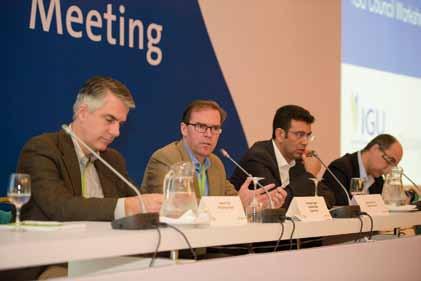
liftoff and China’s slowdown, deleverage and demand rebalancing. He highlighted the following points from the 2015 Lima World Bank meetings held earlier in October: ◆
Global growth rotation and the “new mediocrity” commodities glut to drag on;
Risk rotation and capital retrenchment from emerging market economies; Latin America’s
“golden years” are over; and
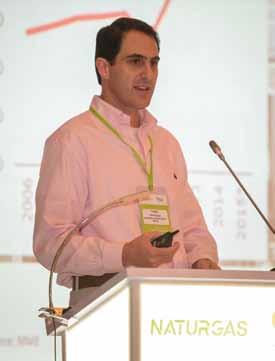
z Timothy Egan,
President and CEO of the Canadian Gas Association and IGU Regional Coordinator for North America led a panel discussion on the Outlook for the Natural Gas Industry.
c Tomás González,
Colombian Minister of Mines, gave a presentation on the Colombian natural gas industry.
z Ed Kelly, Vice President,
Americas Gas and Power Consulting, IHS Energy, gave a presentation focusing on growth and challenges for natural gas markets.
x The regional panel,
moderated by Naturgas President Eduado Pizano, discussed the vital role that gas plays in improving the quality of life in South America.
◆ 2016 is at a crossroads – smooth normalization or going from mediocre to miserable .
Bassam Fattouh from the Oxford Institute of Energy Studies presented an excellent and thought-provoking presentation entitled “The Fall in the Oil Prices and Its Implications on Gas and LNG Markets”. Major conclusions included: ◆ Supply and demand imbalances will continue to put downward pressure on oil prices.
Until stocks are drawn-down, price recovery will be capped; ◆ The supply response is yet to come, but with the advent of US Shale the timing and magnitude of response are more uncertain; ◆ The $100+ oil price environment is unlikely to return in the foreseeable future (unless there is a big supply disruption); ◆ Low oil prices are already having implications for the LNG market: ❚
Accelerated convergence of prices across basins;
Henry Hub is less competitive in Asia reducing incentive to move away from
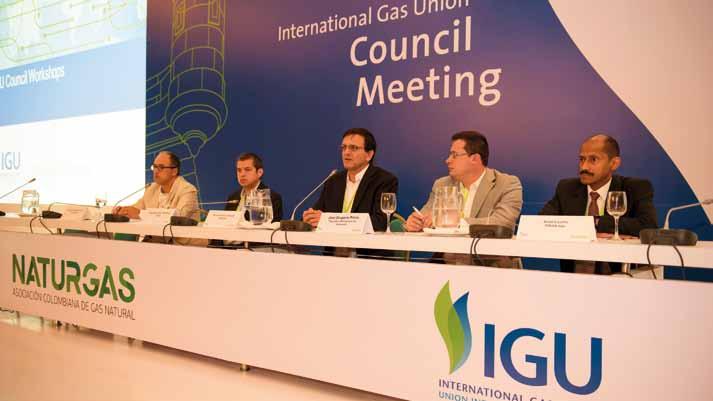
JCC to HH based contracts; ❚ Until 2020, waves of LNG will keep prices low accelerating convergence across markets; ❚ Unwanted LNG from the US and Qatar will likely be diverted to Europe competing with Russian gas; and ❚ Russia’s strategic response will be key to price outcomes and price formations.
Ed Kelly from IHS Energy followed with an equally insightful presentation entitled “Natural Gas Markets – Growth and Challenges”. Major conclusions included: ◆ Supply and demand drivers are moving in opposite directions; ◆ If WTI stays below the $45/bbl level as we expect, then US production will slow sharply in the next few months; ◆ Market opportunity gap – can new projects compete with existing contract extensions?; ◆ IHS LNG supply and demand outlook to 2025 suggests that there is only room for 1-in-15 projects;
Future supply additions likely to come from the US and floating projects; and Demand growth supports higher natural gas prices, but still under $4/MMBtu until late 2021.
Global and Regional Spotlight Workshops
Following the first panel discussion, two excellent and informative panels discussed the role of gas in terms of COP 21 and any potential outcome from the Paris conference as well as the key regional issues and opportunities.
The COP 21 panel was moderated by Dave McCurdy, President and CEO of the American Gas Association and panellists presented the Intended Nationally Determined Contributions (INDCs) of a number of countries including the USA, Japan, South Korea, China and Australia.
An excellent presentation on Statoil’s 2°C HALF-PAGE-NATURGAS-IGU.pdf 1 8/14/15 5:54 PM Pathway was also presented. The final discussion centred around the contribution gas can make in cleaning up the polluted and dirty air of the megacities of the world, the major focus of IGU’s contribution to COP 21.
The regional panel discussion was moderated by Eduardo Pizano and very insightful presentations were made highlighting the extremely important role that gas plays in improving the quality of life in South America. Great opportunities exist for expanded use of gas as presented by panellists from Mexico, Venezuela and Colombia.
The IGU expresses its full appreciation to the many local sponsors that made this event such a success and particularly thanks Eduardo Pizano for his relentless drive and effort to organize such a world-class event.

Diplomatic Gas Forums in Washington DC and Oslo
v The first Washington DC
Diplomatic Gas Forum was held in the headquarters of the American Gas Association.
As part of IGU’s work to raise the voice of gas, two IGU Diplomatic Gas Forums were organized in November and December 2015. The US Presidency has decided to establish a Washington DC-based Diplomatic Gas Forum, utilizing the diplomatic corps for annual discussions about gas industry issues in their respective countries. The Global Ambassadors Network of the US presidency is designed to engage the extensive Washington DC diplomatic corps in the activities of the US presidency over the next three years, and ultimately to be active participants in WGC 2018.
The first meeting of the forum was held in the American capital on November 12, at the headquarters of the American Gas Association and was chaired by Dr Neil Parsan, former Ambassador from the Embassy of Trinidad and Tobago to the United States, and current Secretary for Integral Development at the Organization of American States.
The luncheon event, held just prior to the COP 21 meetings in Paris, featured presentations by IGU President, David Carroll and IGU Secretary General, Pål Rasmussen, while the keynote presentation on the Outlook for the Global Gas Industry was provided by Mary Barcella, Director, North American Natural Gas, IHS Energy. Barcella’s comments focused on the significant growth potential for gas in most regions, and the possible impact of the COP 21 meetings. According to Barcella, energy transitions consistent with a 2°C scenario are compatible with a substantial increase in global gas consumption over the next 15 years, and abundant global gas supplies can play an important role in reducing greenhouse gas emissions.
In commenting on the success of the event, which attracted representatives from over 40 countries, Ambassador Dr Parsan noted, “We look forward to engaging all members of the
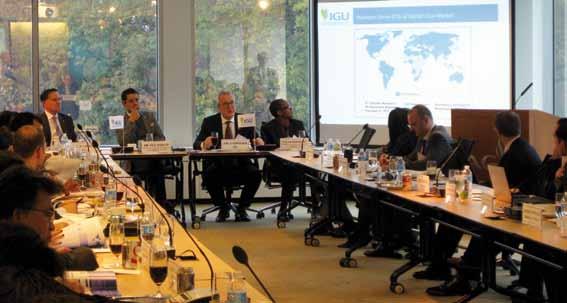
diplomatic corps with the IGU team as we prepare to welcome the global gas industry to Washington in June 2018.”
The IGU Secretariat also organised a diplomatic gas forum in Oslo, Norway. On December 15, IGU and DNV GL, IGU Associate member, invited high-level representatives from the diplomatic missions to DNV GL’s headquarters to discuss how to take full advantage of gas’ potential in the future sustainable energy mix.
This was the third Diplomatic Gas Forum in Norway and under the theme “Natural Gas as a Solution to the World’s Energy and Environmental Challenges”, the event program focused on the opportunities that gas gives for meeting future global energy demand while at the same time reducing global emissions. Presentations were given on this theme, on the link between gas and clean, healthy urban air; and on how challenges of flaring and venting can be addressed. The IEA’s newly released World Energy Outlook 2015 was also presented.
The following outcomes were taken from the forum: Gas definitively has a role to play in the future energy mix. Natural gas is part of the solution both in the transition to, and as part of, a sustainable future energy mix. It is the cleanest fossil fuel and a relatively low-carbon
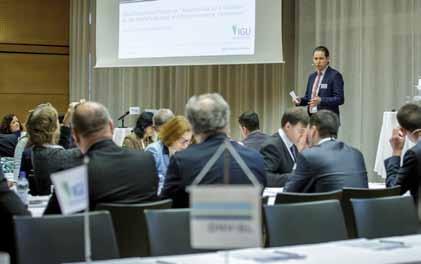
fuel that can help meet CO 2 reductions. It is also a solution to urban air quality problems and can help improve the health and quality of life of millions of people. At the same time, there are also challenges that must be met. More gas infrastructure is needed and this is often a chicken-and-egg problem. Without infrastructure, there is less demand and without demand, there are fewer investments. Flaring and venting are also important challenges. The Oslo event gathered almost 50 delegates, including 26 ambassadors, from 44 embassies accredited to Norway.
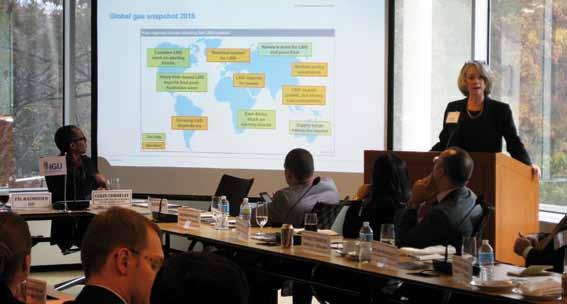
z Remi Eriksen, Group
President and CEO, DNV GL, addressing the Forum in Oslo.
c Mary Barcella spoke










